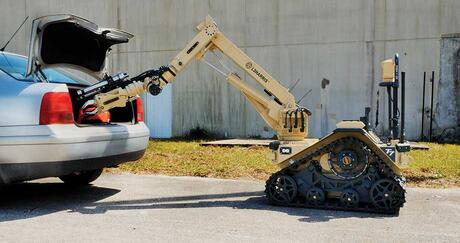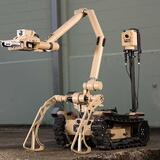But how do you know which size of robot is the right fit for you? With large, medium-sized, and smaller robots to consider, it can be difficult to deduce which size is best suited to your mission. This in mind, we’ve decided to take a look at some of the main advantages, use cases, and challenges across each size of robot to help you gain a clearer understanding of which to invest in and how to best utilize them for maximum gain.
When to choose a large robot
Depending on your mission requirements, it is typically the case that large robots are called upon to tackle bigger threats. They thrive when presented with any type of mission that requires raw power and strength, so if you’re looking to lift a massive amount of weight or drag big objects over long distances – that is when a large robot will excel.
Built to be bulkier, studier and stronger, these systems are usually more robust than their mid-sized equivalents, so are better equipped to deploy powerful explosive ordnance disposal (EOD) disruptors such as HOTROD and PIGSTICK. The same is also true for arm reach – it almost goes without saying that a larger robot will have greater reach and lift strength, meaning operators benefit from extended access and the ability to manage much heavier payloads.
Despite their many advantages, however, larger robots also tend to present several logistical and transportation-based challenges due to their size. In response to these challenges, the latest in medium-sized robots are beginning to close the gap on reach and strength; providing big robot capabilities in a smaller, more easily transported package.
When to choose a medium-sized robot
Medium-sized robots are the perfect middle ground between large and small robots. Able to deliver comparable reach and lift capabilities as their bigger counterparts within a modest, lightweight package, they offer the best of both worlds when it comes to satisfying demanding mission requirements.
Ideally suited to missions with restricted threat access, medium-sized robots are particularly adept at working in highly cluttered environments or tighter spaces such as confined flights of stairs while still enabling the all-important reach and strength capabilities required for difficult tasks. Their reduced size also helps to overcome one of the main obstacles large robots face: narrow doorways. One issue this reduced footprint can present, however, is that a number of medium-sized robots are prone to tip over when lifting heavy objects due to the fact their footprint is relatively small and their center of gravity is quite high.
Another key advantage of medium-sized robots is that they are relatively easy to deploy. Many are small enough to fit into most passenger vehicles and are often able to be lifted by only two people. This is great news for any customers looking to deploy systems domestically, providing the ability to respond much more rapidly and deploy a greater number of assets at scale and pace.
While generally not as capable as larger robots, this is often offset by the aforementioned ease of deployment, as well as a lower procurement cost in comparison to bigger systems. Medium-sized robots are also less power-hungry than large robots, so require fewer batteries.
When to choose a small robot
Much smaller robotic systems can also play a critical role in supporting military personnel. These small robots are strong options for reconnaissance missions, as they can get into very small spaces with ease. Some robots are so small and light, in fact, that they can even be thrown through a building’s window to access higher stories that much faster.
The main benefits to utilizing small robots are that they are inexpensive to procure and great for fitting in a backpack for convenient transportation and deployment. They’re the perfect size for recon, and can even sometimes offer recoilless disruption for minor EOD challenges. When it comes to tasks that require superior arm reach and sheer strength, however, bigger robots are much better equipped to handle such scenarios. This only goes to show that not every robot is suited to the same range of tasks – different sizes are often required for very different purposes.
Our T4™ robot is closing the gap
While it’s true different robot sizes are typically suited to different types of tasks, more recently the lines between what small, medium, and large robots are capable of have begun to blur. Take our own medium-sized T4™ robot as an example: the first ever robot of its size able to deploy big EOD disruptors, it’s changing the game for the mid-sized market. By harnessing best-in-class reach and lift strength only previously available in larger robots, operators are able to perform jobs that up until now wouldn’t have been possible with a medium-sized robot. As a result, it is a highly capable system that even rivals its larger “brother”, the T7™.
Usually, having a long robot arm with high lift capability can cause stability problems if the robot reaches to the side to pick up something heavy. This is not a problem for the T4. Even when its arm is fully extended and working hard, it won’t fall over. This is because, as well as having a super low center of gravity, the T4 benefits from unique omni-directional stabilizers, which provide lateral stability for heavy lifting. These stabilizers also mean that in the rare instances the T4 does tip over, it is able to autonomously self-right, meaning no physical human intervention is required. What’s more, the stabilizers provide tremendous mobility benefits, allowing the robot to lift itself up and over obstacles.
Offering large-robot reach, large-robot strength, and omni-directional stability, the T4 delivers big robot capabilities in a medium-sized package.
Pushing the envelope of robot capability
Within their respective weight classes, our T4 and T7 robots are two of the most capable systems in the world. They continue to push the envelope of robot capability, challenging the conventions of robot size and breaking new ground to help our customers gain the most possible value from their investment. The T4 has paved the way for capabilities never previously achievable with a medium-sized robot, and the T7 is currently the large robot of choice for the UK Ministry of Defence (MOD) and the US Air Force. Regardless of size, our robots are achieving big things; a testament to our hard work and dedication in ensuring they’re fully equipped to deliver the right capabilities for all of our customers’ missions.



